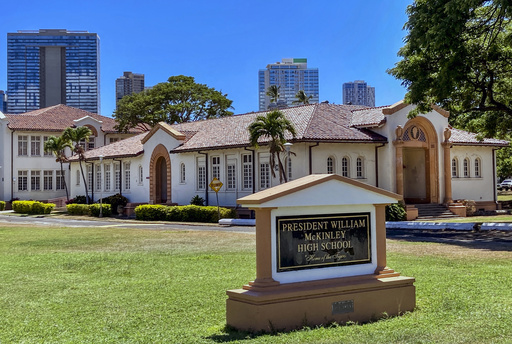HONOLULU — Suzanne Chun Oakland, a former lawmaker in Hawaii, reminisced about a haunting morning in 1977 when she arrived at McKinley High School in Honolulu. On that day, she and her friends learned that a fellow student, Dawn Momohara, had been found dead within the school premises. “News spread quickly, though I don’t recall how we first heard it,” Chun Oakland reflected. Despite not knowing Momohara personally, the tragedy of the unsolved case has lingered with her and many from the school community for nearly fifty years. Last week marked a significant breakthrough when police used emerging DNA technology to arrest a suspect, a 66-year-old resident of a nursing home in Utah.
The accused, Gideon Castro, a former McKinley student, appeared in court via video link from a hospital room in a Utah jail. Castro expressed a desire to procure his own legal representation and is scheduled to reappear in Salt Lake County District Court for an initial hearing. Currently being held on a $250,000 bond, he is facing the possibility of extradition back to Honolulu.
Chun Oakland expressed her sorrow upon learning of the arrest and reflected on the fear that perhaps the suspect could have harmed others over the years. “I think for our student body, of course, there’s that concern that what if he’s still out there and he does it to somebody else,” she said.
On March 21, 1977, shortly after 7:30 a.m., law enforcement discovered Momohara’s lifeless body, partially clothed with an orange cloth tightly wrapped around her neck. It was determined that she had been sexually assaulted and strangled.
Grant Okamura, who was teaching band at the school at that time, recalled the tragic day vividly. He remembered that one of Momohara’s sisters, a student in his class, arrived at school unaware of what had transpired. When the tragic news reached the girl, her devastation left a profound impact on the classroom, making it impossible for Okamura to conduct lessons as his students rallied around her in support.
Okamura doesn’t remember the sister’s name, and attempts to contact potential relatives of Momohara have been unsuccessful. He only faintly remembers meeting Momohara on a couple of occasions when she would wait for her sister in the band room, which was air-conditioned. The day before her tragic death, Momohara had communicated with her mother about going to a local shopping center with friends, marking the last time her mother would see her, as reported by homicide Lieutenant Deena Thoemmes.
As the investigation unfolded in 1977, police released sketches of a potential suspect and a vehicle described by witnesses as a Pontiac LeMans from 1974 or 1975. A witness described seeing the car near the school grounds the night before, but by the time he circled back, both the car and the man were gone.
Despite attempts to uncover leads, the case quickly went cold, casting a long shadow over the school that remained palpable for years. However, in 2019, a dedicated team revisited the cold case, requesting the forensic biology unit to reexamine vital evidence, including items collected from the crime scene. This effort yielded a viable DNA profile by 2020, and in 2023, new information was brought to light concerning two brothers previously questioned in the case.
After Momohara’s death, Castro was interviewed by detectives, stating he had encountered her at a school dance and had last seen her at a carnival on campus before her tragic end. Detectives also questioned his brother, who had similar interactions with Momohara. In a surprising turn, Honolulu investigators located the brother in Chicago and discreetly acquired DNA from his child, confirming he was not responsible. However, DNA evidence from Castro and his son pointed to him as the leading suspect, culminating in Castro’s arrest last week.
Both Okamura and Chun Oakland found it difficult to recall any specific memories of Castro. Chun Oakland, a graduate of the class of 1979, went on to serve as a Democratic senator in Hawaii. The case of Momohara’s murder weighed heavily on her mind throughout her career, especially as she met other victims through her roles as a lawmaker and as part of a nonprofit supporting survivors of sexual assault. She articulated her gratitude for finally achieving an arrest, reinforcing the importance of preserving evidence to seek justice for victims, regardless of the time elapsed.
